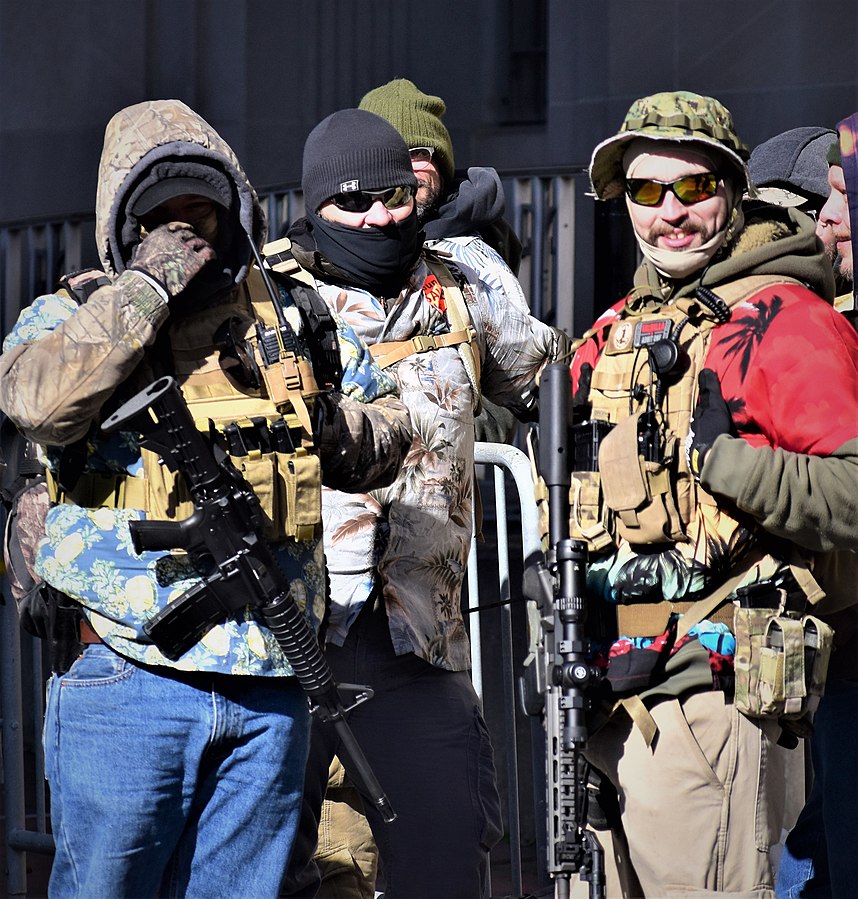 Photo Courtesy: Anthony Crider on Flickr, https://bit.ly/3cADQiH
Photo Courtesy: Anthony Crider on Flickr, https://bit.ly/3cADQiH
Gonzo Extremism: The Boogaloo Boys
The Boogaloo boys have become a more mainstream phenomenon in recent months because of their appearances at anti-lockdown and BLM protests. Typically cast as a far-right extremist group, the loosely organized Boogaloo movement holds a diverse spectrum of adherents who generally rally around a call for a violent insurrection to counter governmental tyranny. The real threat posed by the emergence of movements like Boogaloo is not short-term violence, but the long-term implications radicalization priming could have for the fight against domestic extremism. Radicalization priming can be defined as the initial steps taken that render an individual receptive or sympathetic to extremist messaging.
Overview of the Boogaloo Movement
Identification
- Boogaloo members are best known for wearing Hawaiian shirts, assault rifles, and tactical gear; some also wear igloo patches and tricorn hats.
- The Boogaloo “uniform” is unique because of its duality. It both acknowledges the bizarre, meme-based origins it hails from, but also invokes a serious tone with armaments.
Language
- The term ‘Boogaloo’ comes from the 1984 film Breakin’ 2: Electric Boogaloo. The film itself has little meaning, but internet culture’s adaptation of the term ‘Electric Boogaloo’ as a prototype for bad sequels eventually led to ‘Boogaloo’ becoming code for a second civil war.
- Members refer to themselves as Boogaloo boys (or bois) and ‘Boojahideen.’
- Linguistic evolutions, such as Boogaloo’s contortion into terms like “big luau” and “big igloo”, are common in meme culture, but also function as an evasion tactic in response to social media bans.
Ideology
- As a leaderless movement, there is no cohesive ideology. Member identities range from left-wing libertarians, to anarcho-capitalists, to ultra-nationalists.
- An important distinction to make is that the primary focus centers on overall anti-government sentiment, though a pro-gun sentiment is also a factor. What ties members together is their belief that a violent uprising, or second civil war, is inevitable and necessary to counter a tyrannical government.
- The movement’s reverence towards the infamous Oklahoma City bombing and the Waco and Ruby Ridge standoffs, as well as their involvement in anti-lockdown and BLM protests, leads most extremist experts to classify the overall movement as far-right.
Online Presence
- Boogaloo originated as a 4chan meme in the early 2010s, but its recent movement to mainstream social media platforms such as Facebook has allowed for its message to proliferate.
- Veterans are more likely to be exposed to Boogaloo due to the overlap between military humor, anti-government, and firearm communities. Those struggling with reintegration, who may also hold beliefs that political conflict is best dealt with armed struggle, are often targeted by anti-government extremist groups for their paramilitary skills.
The Implications for U.S. National Security
Short-term:
The immediate threat posed by the Boogaloo movement is one of unpredictable violence. As the movement continues to burst beyond its online bubble, the consequences it carries are very real. In recent months, Boogaloo-connected individuals have been linked to murder, the intention to provoke violence at rallies, and attempts to provide material support to Hamas. Factors such as increasing political polarization, further lockdown measures, racial justice protests, and the upcoming presidential election could set the stage for an escalation of further violence from Boogaloo-linked members in the near future.
Due to differing ideologies within the movement, the eventual cohesion into a well-organized group seems unlikely. Although this might ultimately be a good thing, the nature of uncertainty poses a problem for law enforcement and security officials, especially as it adds to the difficulty of addressing domestic extremism without a proper statute.
Long-term:
The amorphous nature of the group allows for ideological blurred lines and recruitment drives by more nefarious and well-organized groups. White supremacists have adopted the phrase ‘Boogaloo’ as a rallying call for the incitement of a race war. By injecting themselves and further “graying” the area, the doors open for more aggressive recruitment from these groups. The DHS secretary’s recent admission that white supremacy is the “most persistent and lethal internal threat” to the U.S. should establish the potential for recruitment from loosely organized movements as cause for concern.
Using memes as propaganda has long been a tactic used by fringe extremist groups. However, the disorganized nature of recently prominent groups that have utilized them, such as Boogaloo, has done more to radicalize individuals rather than outright recruit them. The threat here is that radicalization primes vulnerable individuals, especially veterans, to be recruited by more violent and organizationally-capable groups, such as The Base and the National Socialist Order. The grey areas and subsequent radicalization provided by loosely organized groups can allow for the intersection of different online communities to converge, in effect creating a breeding ground for domestic extremist groups to capitalize on.
The failure to grasp the long-term implications associated with radicalization priming, as well as the nuances between radicalization and recruitment, could make the United States’ fight against domestic extremism that much harder.





